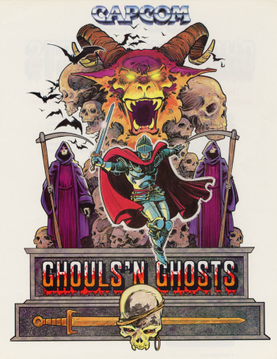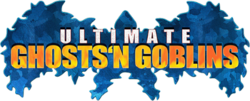
Ghouls 'n Ghosts, known as Dai Makaimura in Japan, is a side-scrolling platform game developed by Capcom, released as an arcade video game in 1988 and ported to home platforms. It is the sequel to Ghosts 'n Goblins and the second game in the Ghosts 'n Goblins series.

Ghosts 'n Goblins, known as Makaimura in Japan, is a platform video game developed by Capcom and released for arcades in 1985. It is the first game in the Ghosts 'n Goblins franchise, and it has been ported to numerous home platforms.

Maximo: Ghosts to Glory, known in Japan, Korea, Europe and Australia as Maximo, is a 3D hack and slash platform video game developed by Capcom for the PlayStation 2. The game is based on the Ghosts 'n Goblins universe and features original character designs by Japanese illustrator Susumu Matsushita. The game was followed by a sequel, Maximo vs. Army of Zin in 2003.

Trojan is a side-scrolling action game developed by Capcom, originally released as a coin-operated arcade video game in 1986, and published in North America by Romstar and Capcom. Directed by Takashi Nishiyama, the game includes beat 'em up and hack-and-slash elements. It is a spiritual successor to the beat 'em up Kung-Fu Master (1984), which was designed by Nishiyama at Irem before he left for Capcom, where he evolved its gameplay concepts with Trojan. It is also considered a spiritual successor to Capcom's Ghosts 'n Goblins (1985), which has similar side-scrolling action gameplay elements.

Demon's Crest, known in Japan as Demon's Blazon, is a side-scrolling platform video game developed and published by Capcom for the Super Nintendo Entertainment System. It is the third video game starring Firebrand, following Gargoyle's Quest and Gargoyle's Quest II.

Capcom Classics Collection is a compilation of arcade games released by Capcom for the PlayStation 2 and Xbox on September 27, 2005 in North America and in 2006 in Japan. It was developed by Digital Eclipse Software, Sensory Sweep, and its Japanese developer Klein Computer Entertainment. A second volume, Capcom Classics Collection Vol. 2, was released on November 24, 2006 in North America, for PlayStation 2 and Xbox. The second volume as well as the Xbox version of the first volume were not released in Japan.

SNK vs. Capcom: SVC Chaos is a 2003 fighting game produced by Playmore for the Neo Geo arcade and home platform. It was then later ported to the PlayStation 2 and Xbox, although only the Xbox port was released in North America and both platforms were released in Japan and PAL regions.

Super Ghouls 'n Ghosts, known as Chou Makaimura in Japan, is a platform video game developed and published by Capcom for the Super Nintendo Entertainment System in 1991. As the third game in the Ghosts 'n Goblins series and the first not to be released for the arcade, it again depicts knight Arthur saving Princess Guinevere and the kingdom from Emperor Sardius, who has cast a spell that has revived the Ghoul Realm.

Capcom Generations is a series of five video game compilations produced by Capcom for PlayStation and Sega Saturn. Each volume contains three or four games from a particular series or game genre and were ported directly from their original arcade versions. Each disc also contains a "collection mode" featuring history, tips, artwork, character profiles, arranged music and other unlockable contents for each game. The PlayStation versions of the games also featured support for the DualShock controller.

Ultimate Ghosts 'n Goblins is a video game in Capcom's Ghosts 'n Goblins series, developed by Tose and published by Capcom. It was released for the PlayStation Portable on August 13, 2006, in Japan and August 29, 2006, in North America. Ultimate Ghosts 'n Goblins is the first game in the main series to employ 3D graphics, while maintaining much of the 2D gameplay mechanics of the earlier games. It also marks the return of the series' project head, Tokuro Fujiwara.

Gargoyle's Quest is an action-adventure platform game developed by Capcom for the Game Boy and released in 1990. It is a spin-off of the Ghosts 'n Goblins series, featuring the series antagonist character Firebrand as the main playable character. Gargoyle's Quest was followed by the NES prequel Gargoyle's Quest II in 1992 and the Super NES sequel Demon's Crest in 1994.

Gargoyle's Quest II: The Demon Darkness is a 1992 action-adventure game released on the NES by Capcom. It is the prequel to Gargoyle's Quest and features a similar gameplay style, which combines adventure elements with side-scrolling action in a macabre fantasy setting.

Arthur to Astaroth no Nazomakaimura: Incredible Toons is a 1996 puzzle video game for the Sega Saturn and PlayStation which was only released in Japan. Capcom licensed Dynamix's Sid & Al's Incredible Toons engine with a Ghosts 'n Goblins motif, so it is essentially a sequel to that game. The game was initially completed without the Ghosts 'n Goblins characters, which Capcom decided to add in at the last minute.
The Goetic demon Astaroth, whose name is derived from Ashtoreth, the biblical spelling of the name of the Phoenician goddess Astarte, has appeared many times in modern popular culture.

Ghosts 'n Goblins: Gold Knights and Ghosts 'n Goblins: Gold Knights II, released in Japan as Makaimura Kishi Retsuden and Makaimura Kishi Retsuden II respectively, are a pair of run and gun platform games developed and published by Capcom for iOS. Both titles were removed from the Apple App Store on May 10, 2016.

The gargoyle is a fantasy and horror monster inspired by the appearance of bestial grotesque statues in architecture - particularly those sculpted to decorate the cathedral of Notre-Dame de Paris during its 19th-century reconstruction, rather than actual medieval statuary. Its name is based on the gargoyle architectural element, whose name is often incorrectly conflated with that of monstrous grotesques as a whole.

Capcom Arcade Stadium is a 2021 video game compilation by Capcom released for digital distribution. It includes 32 arcade games originally published by Capcom between 1984 and 2001. The compilation was initially released on Nintendo Switch, then on PlayStation 4, Windows, and Xbox One, and later Amazon Luna. A second compilation, Capcom Arcade 2nd Stadium, was released in 2022.

Ghosts 'n Goblins Resurrection is a platform game developed and published by Capcom for the Nintendo Switch. It is the 8th game in the Ghosts 'n Goblins series and was released on February 25, 2021 to celebrate the series' 35th anniversary. Ports for PlayStation 4, Windows, and Xbox One were released on June 1, 2021. The game received mixed reviews upon release.

















